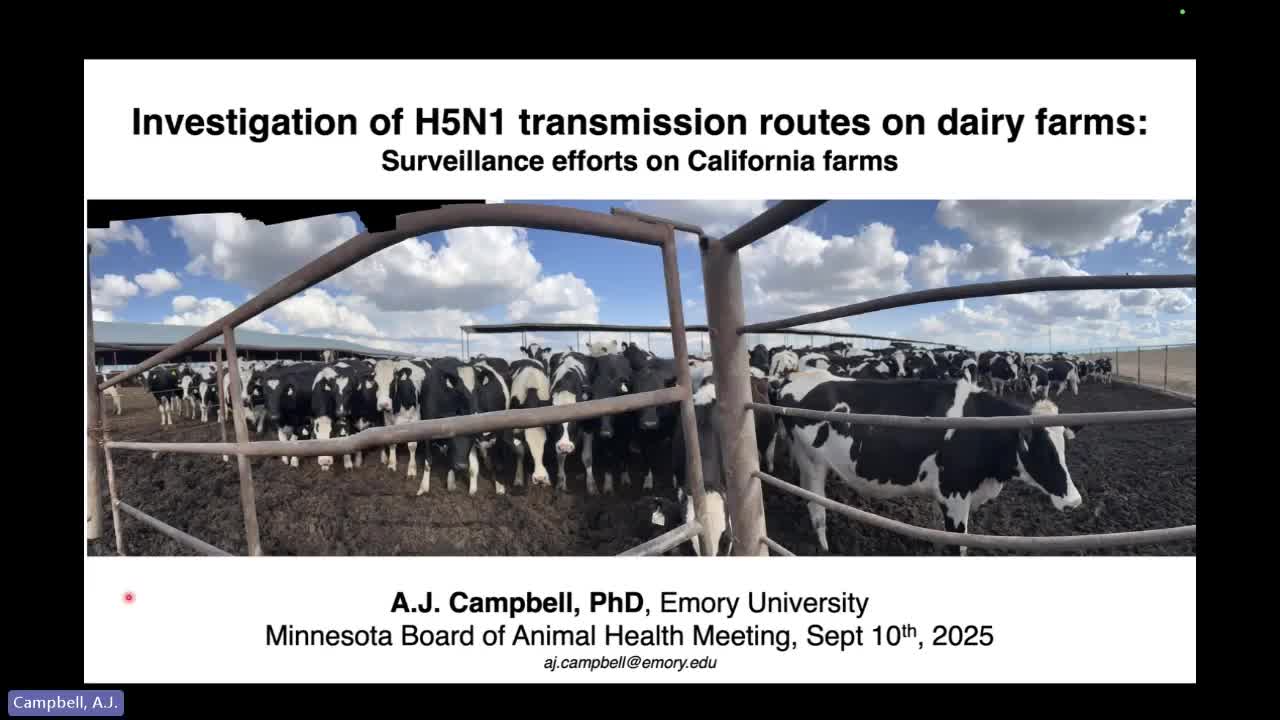Research Team Investigates H5N1 Transmission Routes in California Dairy Farms
September 11, 2025 | Board of Animal Health, Agencies, Boards, & Commissions, Executive, Minnesota
This article was created by AI summarizing key points discussed. AI makes mistakes, so for full details and context, please refer to the video of the full meeting. Please report any errors so we can fix them. Report an error »

In a recent meeting held by the Minnesota Board of Animal Health, experts gathered to discuss critical findings from ongoing research into the transmission of highly pathogenic H5 avian influenza among dairy cows. The meeting, which took place on September 11, 2025, highlighted the collaborative efforts of scientists, dairy farmers, and veterinary clinics in addressing this pressing issue.
Dr. Aaron, a molecular virologist with a background in plant pathology, opened the discussion by acknowledging the extensive teamwork involved in the project. He emphasized the importance of understanding how the virus spreads, particularly in milking parlors where cows and workers are in close contact with potentially contaminated milk. The outbreak, first reported in Texas and Kansas in March 2024, has raised alarms due to its severe impact on dairy production and animal health.
The research team focused on five potential routes of transmission originating in the milking parlor. They found that parlor workers, often with minimal personal protective equipment, were at risk of exposure through milk-based aerosols. Additionally, the disposal of contaminated milk into wastewater streams posed a significant threat, as wildlife could access these areas, potentially spreading the virus further.
Sampling efforts across 14 dairies in California revealed that the virus was frequently detected on milking equipment and in the air of the milking parlors. Notably, the study found infectious virus present in the air, suggesting that aerosol transmission could be a viable route for the virus to spread among cows. The researchers also examined wastewater management practices, discovering that high concentrations of the virus could persist in manure lagoons, which are often accessible to wildlife.
Dr. Aaron's team conducted a longitudinal study to track H5 positivity in individual quarters of cows over time. While they observed that cows with mastitis were more likely to test positive for the virus, the results indicated that infection did not spread uniformly among the quarters, suggesting that milking equipment might play a role in transmission.
The findings underscore the need for effective risk mitigation strategies centered around the milking parlor and wastewater management. As the meeting concluded, Dr. Aaron expressed hope that their research would contribute to a better understanding of transmission dynamics, ultimately aiding in the prevention of future outbreaks.
The ongoing nature of this research, including plans to study antibody presence in milk and blood, reflects the commitment of the Minnesota Board of Animal Health and its partners to safeguard animal health and the dairy industry. As the team continues to analyze data and refine their strategies, the implications of their work extend beyond California, resonating with dairy farmers and veterinarians across the nation.
Dr. Aaron, a molecular virologist with a background in plant pathology, opened the discussion by acknowledging the extensive teamwork involved in the project. He emphasized the importance of understanding how the virus spreads, particularly in milking parlors where cows and workers are in close contact with potentially contaminated milk. The outbreak, first reported in Texas and Kansas in March 2024, has raised alarms due to its severe impact on dairy production and animal health.
The research team focused on five potential routes of transmission originating in the milking parlor. They found that parlor workers, often with minimal personal protective equipment, were at risk of exposure through milk-based aerosols. Additionally, the disposal of contaminated milk into wastewater streams posed a significant threat, as wildlife could access these areas, potentially spreading the virus further.
Sampling efforts across 14 dairies in California revealed that the virus was frequently detected on milking equipment and in the air of the milking parlors. Notably, the study found infectious virus present in the air, suggesting that aerosol transmission could be a viable route for the virus to spread among cows. The researchers also examined wastewater management practices, discovering that high concentrations of the virus could persist in manure lagoons, which are often accessible to wildlife.
Dr. Aaron's team conducted a longitudinal study to track H5 positivity in individual quarters of cows over time. While they observed that cows with mastitis were more likely to test positive for the virus, the results indicated that infection did not spread uniformly among the quarters, suggesting that milking equipment might play a role in transmission.
The findings underscore the need for effective risk mitigation strategies centered around the milking parlor and wastewater management. As the meeting concluded, Dr. Aaron expressed hope that their research would contribute to a better understanding of transmission dynamics, ultimately aiding in the prevention of future outbreaks.
The ongoing nature of this research, including plans to study antibody presence in milk and blood, reflects the commitment of the Minnesota Board of Animal Health and its partners to safeguard animal health and the dairy industry. As the team continues to analyze data and refine their strategies, the implications of their work extend beyond California, resonating with dairy farmers and veterinarians across the nation.
View full meeting
This article is based on a recent meeting—watch the full video and explore the complete transcript for deeper insights into the discussion.
View full meeting
